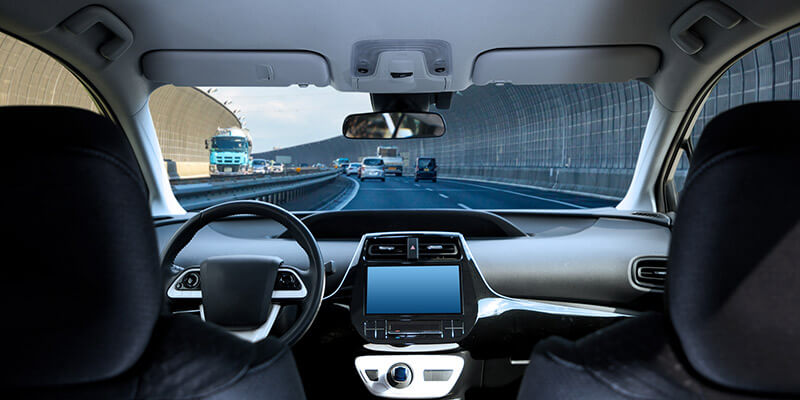The Race to Autonomous Vehicles
- Written By Michael Goldman

The $2 trillion global automotive industry is ripe for disruption from autonomous vehicle technologies that make driving safer, more energy-efficient and more convenient. Driver error causes more than 9 out of 10 crashes. Autonomous vehicles are robots on wheels that eliminate driver perception, distraction and incapacitation errors. While cybersecurity risk poses a safety threat, there is little doubt that robots can drive better than humans under normal conditions. Most autonomous vehicles are powered by eco-friendly, zero-emission electric batteries, and they are designed to drive safely and efficiently. Autonomous vehicles offer limitless opportunities for convenience by changing the driver into a passenger.
Following several years of product and strategy improvements along with making progress in gaining regulatory approvals for road testing, the major players are emerging in the race to commercialize fully autonomous vehicles. To name a few, Waymo started as Google’s self-driving car project and is a self-driving taxi service currently operating in Phoenix, Arizona with a pilot program for employees in California. Waymo is the largest active self-driving company in terms of daily miles driven. General Motors’ Cruise provides an autonomous ride-hailing service for its employees in San Francisco and recently unveiled plans for its fully autonomous Origin with no steering wheel or pedals. Volkswagen and Ford have made large investments in self-driving software company Argo AI with plans to implement Argo AI’s software in new vehicles in the early 2020s. Uber is heavily investing in replacing its human fleet with a driverless fleet. Startups like Optimus Ride and Pony.ai have launched self-driving ride-hailing services in designated areas of cities like Brooklyn’s Navy Yard.
These companies have really smart people, breakthrough technologies and deepening pockets. And they are all watching Tesla whiz by in the race to commercialize autonomous vehicles.
Here are several reasons why.
ADVANCED TECHNOLOGY WITH NO BOUNDARIES
Tesla’s autonomous vehicle system primarily uses cameras to identify stationary and moving objects in the vehicle’s surroundings. Radar and other sensors are used to help see in dark and adverse weather conditions. The Autopilot system is a standard feature and currently qualifies Teslas for SAE Level 2 Automation, which means it can handle all aspects of driving under certain conditions, but the driver must be ready to intervene at all times. Tesla deploys the hardware needed for self-driving in all of its vehicles sold to consumers, and they use the hardware to train artificial intelligence systems called neural networks that are designed to automatically improve with new data.
Virtually all major players except Tesla are using LiDAR technology to build autonomous vehicles. LiDAR is a sensor system that measures reflections from laser pulses to build a 3D representation of the environment around the vehicle. Geofencing is used to define spatial boundaries, and detailed maps of the terrain and objects within the geofence are developed. The self-driving car projects the sensor data on top of the map to gather information and determine the safest path.
Proponents of LiDAR argue the technology is crucial to reliably assess and measure the environment around the car in all conditions. Argo AI describes a “street-by-street, block-by-block” mindset[1] underlying their LiDAR-based technologies to make self-driving vehicles safe and accepted by society. The goal of this approach is SAE Level 4 Automation, which does not require any human intervention in limited spatial areas.
Elon Musk, Tesla’s founder and CEO, criticized the use of LiDAR in autonomous vehicles at Tesla’s 2019 Autonomy Day event. “In cars, it’s freaking stupid. It’s expensive and unnecessary…once you solve vision, it’s worthless. So you have expensive hardware that is worthless on the car.”[2] He has a point. Although the per unit cost of LiDAR is dropping, it still costs a few thousand dollars per vehicle. Researchers at Cornell University found that cameras can detect objects with near the precision of LiDAR at a fraction of the cost[3]. Also, developing capacity for LiDAR use by geofencing and mapping communities is costly and slow whereas camera-based systems can be employed in cars anywhere in the world. Musk’s goal for Tesla is SAE Level 5 Automation, which does not require any human intervention with no spatial limitations.
TESLA HAS THE DATA
Training a self-driving car requires a lot of data. Tesla has over 3.3 billion Autopilot miles and 22.5 billion miles in Tesla vehicles[4] from its fleet approaching 1 million units sold worldwide. On an average day, Tesla collects approximately 650x more driving data than Waymo.[5] Tesla feeds the vast amount of data it is collecting into its advanced neural networks, which use the data to improve the vehicle’s ability to predict common behaviors as well as behaviors for rare situations that are difficult to simulate. Although Autopilot is currently intended only for use on highways, Tesla is using the data it gathers in all environments to train its cars how to handle intersections, traffic lights and pedestrians.
VERTICAL INTEGRATION FOSTERS INNOVATION
Many autonomous vehicle companies are partnering with automotive companies to implement their self-driving platform into new vehicles. Waymo has equipped several types of cars with its self-driving equipment. Argo AI partnered with Ford and Volkswagen to roll out its autonomous vehicle technology in both the U.S. and Europe. Daimler has partnered with Baidu to equip Baidu’s Apollo program, an open-source autonomous vehicle platform, onto Daimler’s Mercedes-Benz vehicles to test self-driving vehicles in Beijing, China.
Tesla is an automotive company and an autonomous vehicle company, allowing the company to fully integrate hardware and software autonomous vehicle specifications into its vehicle design and build processes. Large automobile companies typically source their parts from suppliers all over the world who can meet their quality demands at the lowest cost. Tesla learned the dangers of a global supply chain the hard way when its Model X deliveries fell far short of demand in early 2016 caused by a shortage of parts from a supplier. Tesla has moved many parts manufacturing operations in-house, which has led to new types of batteries, seats, motors, windows and other parts that differentiate Tesla from the competition. Bringing parts manufacturing in-house allows Tesla to be flexible and nimble in pushing improvements into its products. Musk noted Tesla pushed 20+ improvements per week into the product development process of Model S[6]. Tesla’s culture of continuous improvement is key for automation where iterative development is required to make driverless cars safe.
SELF-DRIVING TESLAS ARE STILL PERSONAL AUTOMOBILES
Most autonomous vehicle companies are intending to provide ride-hailing services. These companies are making big bets on the future of shared vehicles, but they don’t have much choice. Consumers do not want to buy a personal automobile that doesn’t operate outside of the town’s geofence, and the LiDAR-based system is costly equipment to pass on to the consumer. A vehicle-sharing model makes sense in highly congested urban areas where parking space is limited, but it will not displace personal automobiles anytime soon. Car owners value the accessibility and independence of having their own vehicle. Also, in the new era of social distancing and extra health safety precautions, vehicle sharing and ride sharing faces serious headwinds.
In contrast, when Musk and the regulators determine Tesla’s fully autonomous vehicle technology is safe for use, a simple over-the-air software update can transform Tesla’s automobile fleet into a fleet of driving robots with human-driver capabilities.
In 2019, Musk predicted Tesla’s self-driving vehicle technology will be feature-complete by the end of 2020. While this timeframe seems overly aggressive, I hesitate to doubt Musk. After all, one of Musk’s other companies, SpaceX, just became the first private company to send humans into orbit, and the company is seeking to send humans to Mars and beyond. Compared to space travel, teaching robots to drive safely at 55 miles per hour is a manageable problem.
In reality, there will be room for many winners in the autonomous vehicle market. Global automakers like Volvo, BMW, Nissan and Toyota have stumbled out of the gates in building self-driving vehicles, but they continue to invest and will not be far behind. Ride-hailing startups could shift consumer preferences on car ownership if people are able to order a ride on their phone anytime, anywhere. Autonomous vehicles have the potential to be used for a multitude of purposes including for commercial cargo transportation and in vehicles used for urban commuting or long-distance transit.
The time is now to start planning your insurance needs for the autonomous vehicle age. Contact our product development and product design experts for help.
[1] https://www.argo.ai/2019/09/the-argo-ai-approach-to-deploying-self-driving-technology-street-by-street-block-by-block/
[2] https://www.theverge.com/2019/4/24/18512580/elon-musk-tesla-driverless-cars-lidar-simulation-waymo
[3] https://www.therobotreport.com/researchers-back-teslas-non-lidar-approach-to-self-driving-cars/
[4] https://lexfridman.com/tesla-autopilot-miles-and-vehicles/#:~:text=The%20following%20is%20a%20plot,Tesla%20vehicles%3A%2022.5%20billion%20miles
[5] https://towardsdatascience.com/why-teslas-fleet-miles-matter-for-autonomous-driving-8e48503a462f
[6] https://www.caradvice.com.au/367472/tesla-model-s-gains-20-engineering-changes-per-week/





